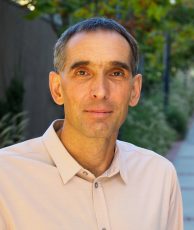
Dimitri (Dima) Shlyakhtenko was appointed Director of IPAM on July 1, 2017. Shlyakhtenko has been a member of the faculty at UCLA department of mathematics since 1998, and served as the department chair from 2012 to 2015. His research is on Operator Algebra and includes free probability theory, random matrix theory, as well as von Neumann algebras and L2-invariants. He received his PhD from University of California, Berkeley in 1997. He was the recipient of a Sloan Foundation Fellowship in 2001 and a Special Project Award from the Clay Mathematics Institute in 2002. The UCLA department of mathematics presented him with the R. Sorgenfrey Distinguished Teaching Award in 2004. He gave an invited talk at the International Congress of Mathematicians in Hyderabad, India in 2010.

Christian Ratsch grew up in Berlin, Germany, where he received his undergraduate education at the Technical University. He moved to the United States in 1988, where he completed his PhD in physics at Georgia Tech in 1994. After a short appointment at the Imperial College in London and a two-year post-doc at the Fritz-Haber-Institut in Berlin, Ratsch came to the UCLA Mathematics Department in 1997. He has been at UCLA since then, and joined IPAM as the Associate Director in 2006, and became Deputy Director in 2018. Ratsch’s research interests are mathematical and physical modeling and simulation of problems in materials sciences on all appropriate time and length scales.
His expertise includes density-functional theory (DFT), stochastic, atomistic models (KMC), and continuum type models (level-sets). The research topics of his research group include modeling and simulation of growth of thin films and nanostructures, design and optimization of new hybrid solar cells, and design and optimization of new heterocrystals.

Selenne Bañuelos is an associate professor of mathematics at California State University Channel Islands in Camarillo, CA. She received her BS in mathematics from UCSB in 2007 and her PhD in applied mathematics from the University of Southern California in 2013. Her research is in mathematical biology. Her recent projects are on a mathematical model of sleep and thermoregulation, and a mathematical model on combination treatment of phage and antibiotics to treat illnesses associated with multi-drug resistant organisms. The latter project began during her participation in the Collaborative Workshop for Women in Math Bio at IPAM. She was the recipient of the MAA Henry L. Alder Award in 2020. Selenne grew up in Los Angeles, in the Boyle Heights neighborhood.
.

Stan Osher grew up in Brooklyn, New York and obtained his PhD from the Courant Institute at NYU. After working at Brookhaven National Laboratory, UC Berkeley, and SUNY Stony Brook, he arrived at UCLA in 1976 as a visiting Professor and never left. Dr. Osher has co-invented and developed: the level set methods for computing moving fronts involving topological changes; essentially nonosillatory high order methods for approximating hyperbolic conservation laws and Hamilton-Jacobi equations; total variation and other partial differential equation based image processing techniques; fast optimization algorithms for L1 based regularization, and diffusion generated geometric motion. Among his many honors, he has given regular (1994) and plenary (2010) invited addresses at the International Congress of Mathematicians and the John von Neumann lecture at the annual SIAM meeting; he is a fellow of SIAM, the AMS, and the American Academy of Arts and Sciences; and is a member of the National Academy of Sciences.